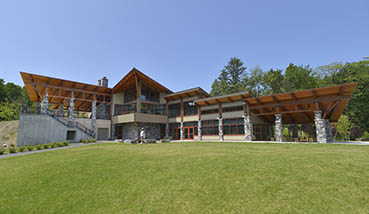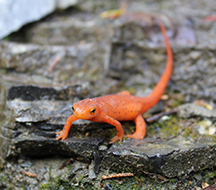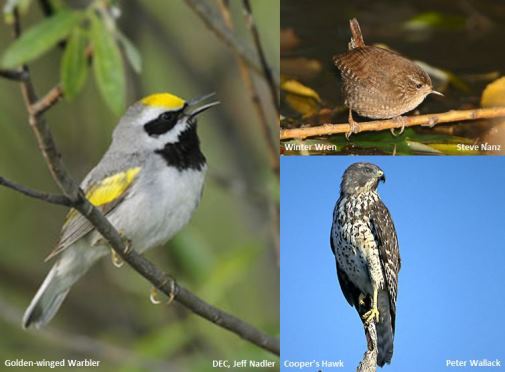Thacher State Park

Thacher State Park
The Indian Ladder Trail is officially open for the 2025 season
830 Thacher Park Road
Voorheesville, NY 12186
- General Information: (518) 872-1237

Support the New Thacher Park Center: Sponsor a Brick Paver
John Boyd Thacher State Park is situated along the Helderberg Escarpment, one of the richest fossil-bearing formations in the world. Even as it safeguards six miles of limestone cliff-face, rock-strewn slopes, woodland and open fields, the park provides a marvelous panorama of the Hudson-Mohawk Valleys and the Adirondack and Green Mountains. The park has volleyball courts, playgrounds, ball fields and numerous picnic areas with eight reservable shelters. Interpretive programs are offered year-round, including guided tours of the famous Indian Ladder Trail. There are over 25 additional miles of trails for hiking, mountain biking, winter cross-country skiing, snowshoeing, and snowmobiling. Learn more, watch WMHT's documentary: 'The Great Ledge: Exploring Thacher'
The Visitor Center located at Thacher State Park has geological and historical exhibits showcasing the Helderberg Escarpment and its' importance on the region. The visitor center has activities for children and adults alike, along with two rentable spaces. There is a conference room for groups under 25, and the Helderberg Room which offers stunning views and a premiere space for weddings and larger celebrations or gatherings.
Sport climbing is available with a completed John Boyd Thacher State Park Risk Climbing Waiver permit. Completed digital permit applications are to be emailed to jbthacher@parks.ny.gov. Permits are now paperless. As a result, you will receive an email that will serve as your permit for the 2024 climbing season. Please have a copy of the email with you while climbing. Please visit the climbingthacher.org website for the opening date of the climbing area.
Camping is available at this park at Thompson's Lake Campground, which features 140 campsites with options of private wooded sites and open, adjacent sites. Sites can accommodate tents or RVs and are all close to restroom and shower facilities.
Wild Play Adventure Course: This new adventure course offers 15 zip lines, 60 aerial games, and a 40 ft jump. For hours and pricing visit www.wildplay.com/thacher/ or call: 1-800-668-7771
The Emma Treadwell Thacher Nature Center is located two miles from the Overlook on Thompson's Lake. The center offers exhibits, interactive displays, trails for hiking and skiing, snow shoe rentals and educational programs.
Voluneteer Opportunities
Are you or your business interested in volunteering with Thacher State Park? We have a range of opportunities available. Please contact our Volunteer Coordinator at
- Email: Thachervolunteer@parks.ny.gov -Office: (518) 872-08000
Thank you for your interest!
Pavilion Information
Thacher has eight pavilions. Prices range from $150 to $250 and can accommodate 40 to 200 people. Check availability at ReserveAmerica.com.
Pet Policy: A maximum of two pets are allowed in campsites and day use areas unless prohibited by sign or directive. Pets are to be supervised at all times and either be crated or on a leash not more than 6-feet in length. Proof of rabies inoculation shall be produced if requested by staff. Pets are not permitted in playgrounds, buildings, golf courses, boardwalks, pools and spray-grounds or guarded beaches (this does not apply to service animals).
Hours of Operation
- The park is open year round, sunrise until sunset.
Emma Treadwell Nature Center is open daily 9am-4pm starting January 1, 2025
Interpretive Programs: Year-round. Call 518-872-0800 for details.- Skiing, Snowmobiling and Mountain Biking: Available on designated trails only.
- Picnic Shelters: May - October. Advance reservations available at reserveamerica.com
Visitor Center: Open 7 days a week 9am-4pm (Closed Thanksgiving and Christmas Day)
Visitor Center Bathrooms open daily 9am-4pm- Day Use/Picnicking/Hiking/Nature: Available year round.
- WildPlay at Thacher: June 2025 hours: Saturdays & Sundays (and June 30), 10am-5pmJuly 1 - August 31: Monday - Friday, 10am-5pm. Saturday & Sunday, 9am-6pm.Closed July 15 for maintenance
Fees & Rates
Most New York State Parks charge a vehicle use fee to enter the facility. Fees vary by location and season. A list of entry fees and other park use fees is available below. For fees not listed or to verify information, please contact the park directly.
The easy-to-use Empire Pass card is $80- and your key to all-season enjoyment with unlimited day-use entry at most facilities operated by State Parks and the State Dept. of Environmental Conservation including forests, beaches, trails and more. Purchase online or contact your favorite park for more information. Learn more about our Admission Programs including the Empire Pass.
- Vehicle Entrance Fee
- $6.00
Collected 9am-5pm daily
May 1 - October 31
Buses: $35 - Helderberg Room Rental
- Please call the park for more information.
- Snowshoe Rental
- Available at both the Nature Center and Visitor Center – by donation
Maps

New! Download this park's digital map to your iOS Apple and Android device.

Highlights of Thacher State Park:
- Thacher has a limestone landscape! The dissolution of limestone bedrock gives rise to Karst features: sinkholes, caves, disappearing streams, and springs.
- The park is a migration corridor for hawks and a Fall Hawk Watch is set up at the park overlook every year during the mid-September peak period. On a good day, hundreds of hawks can be seen passing overhead.
- On the first warm rainy nights in spring, usually late March/early April here, volunteers gather to help salamanders cross the road on their journey to breed in vernal ponds.
- The honeybees in the observation hive at the Nature Center are busy: the queen is laying eggs, and the workers are raising larva and gathering nectar and pollen.
- Ripe nuts from our native trees are an important source of winter food stores for wildlife. On the Helderberg Escarpment, the most abundant nut trees are oak, hickory, and beech. Acorns are especially important winter food for deer, squirrels, and chipmunks.
- With an elevation of over 1100 feet, the Helderbergs average 8 degrees colder than the valley and receive much more snow in the winter. Thacher Park is a favorite destination for cross country skiing and snowshoeing. The ground may be bare in Albany when there is deep snow in the park.
- Thacher's Nature Center was voted into the "Top 20 Places to Take Kids in the Capital Region" by Kids Out and About.
What will you see? Plan your visit today!
Listen for these birds at our Park:
- Common Yellowthroat
- Common Raven
- Eastern Phoebe
- Louisiana Waterthrush
- Pileated Woodpecker
- Turkey Vulture
- Veery
- Eastern Wood-Pewee
Everyone is a Steward: Be a Thacher State Park Hero!
- Keep your dog on a leash to protect ground nesting birds and small mammals in the woods.
- Use trails when geocaching and place caches within 20 feet of the trail.
- Learn about invasive species and volunteer for removal projects.
- Buy your firewood at the campground and leave behind what you don't burn.
For more information, please read our Trail Tips!
Ask a Naturalist!
Q: Can we explore the cliff above and below the Indian Ladder Trail?
A: Please stay on the trail! The slopes can be dangerous with loose rocks and slippery mud. Climbing up the steep banks destroys vegetation and creates erosion problems. Many of the mosses take decades to establish and minutes to destroy. The trail is narrow and the steep slopes are difficult to stabilize. Please stay on the trail to preserve this fragile environment.
Q: Where can we go to see fossils?
A: Much of the rock in the park is limestone and contains fossils of shelled marine animals. They are easiest to find on rocks in streambeds, in the stone wall at the Overlook, and in bare rock exposed along the Cliff Top Trail. Enjoy hunting for fossils, but please remember that collecting is prohibited in state parks.
Q: When and where can we see waterfalls in the park?
A: There are two waterfalls that cascade over the Indian Ladder Trail, one at Hop Field, and at Paint Mine picnic areas. Early spring is best, and after heavy rains in summer and fall. During much the summer, the waterfalls can be completely dry.
Did You Know?
- DID YOU KNOW? In the late 1800s, the Helderbergs became a popular tourist destination and city dwellers hired buggies to bring them up to the resort hotels near the Helderberg Lakes.
- CHECK IT OUT! On a hot summer day, the narrow cave along the Indian Ladder Trail's cliff wall provides cool relief.
- DID YOU KNOW? The Indian Ladder Trail got its name from the felled trees that Native Americans used to climb over the Helderberg Escarpment on their journey between the western hills of the Schoharie Valley and the Hudson River Valley.
"Cliffs Higher Than the Palisades" was just one of the superlatives used to describe John Boyd Thacher State Park after its acquisition in 1914. It was also extolled as a paradise for geologists and acclaimed for its precipitous cliffs and magnificent prospects. Enthusiasts declared its scenery unsurpassed, even in the Adirondacks.

Key BCA Criteria:
- Migratory concentration site
- Diverse species concentration site
- Species at risk site
The John Boyd Thacher/Thompson's Lake BCA consists of portions of two nearly contiguous State Parks in Albany County. John Boyd Thacher sits atop the Helderberg escarpment, a 100 foot high calcareous cliff. The BCA is especially important because its diverse habitats support a wide variety of birds of prey. Thacher is dominated by forested uplands. The Thompson's Lake area consists of additional upland forest, old fields and a bur oak-black ash swamp adjacent to the lake. The lake itself is not owned by OPRHP.
There are 171 species of birds that have been identified within the J.B. Thacher and Thompson's Lake BCA, of which 102 are confirmed or probable breeders, including: Sharp-shinned hawk (Special Concern), Cooper's Hawk (Special Concern), Northern Goshawk (Special Concern) and Golden-winged Warbler (Special Concern). The forests support some of the area's highest densities of breeding songbirds such as Hermit Thrush, Winter Wren, Magnolia, Black-throated Blue, Black-throated Green, Blackburnian, Canada and Worm-eating Warblers and Louisiana and Northern Waterthrushes. J. B. Thacher supported the first recent regional nesting of Common Ravens and is now the nucleus for the population in the area.
Download a copy of the BCA map.
Go birding with the Thacher Park Bird Checklist.
Attention Hunters: Highly Pathogenic Avian Influenza (i.e., "bird flu") has recently been detected in New York State in a variety of waterfowl species. Although the NYS Department of Health (NYSDOH) has stated that avian influenza rarely spreads to humans, the New York State Department of Environmental Conservation (NYSDEC) is encouraging hunters to take extra precautions while processing harvested waterfowl. For more information on best practices for hunters to minimize risk of exposure, please read NYSDEC Highly Pathogenic Avian Influenza - What Hunters Need to Know (leaves State Parks website).
For general information on Avian Influenza, please see: Cornell University, College of Veterinary Medicine - Avian Influenza Fact Sheet (leaves State Parks website).
For additional updates on Avian Influenza, including current updates, see NYSDEC - Animal Diseases (leaves State Parks website) and NYSDOH - Questions and Answers about Avian Influenza (Bird Flu) (leaves State Parks website).
Hunting permits will be issued beginning September 15th.
All persons hunting within the boundaries of the permitted hunting area of Thacher State Park must have a valid NYS hunting license, archery license, muzzle loading license and/or turkey permit as required by Environmental Conservation Law. A special permit, issued by Thacher State Park, is also required. Permits can be obtained at the park office at no charge.
Rifles of any caliber or handgun of any type is strictly prohibited. Muzzle loader or shotgun only. Bow hunting in designated areas. With the exception that all hunting ends on February 28 of each year, the hunting schedule follows the hunting season as outlined by New York State DEC for NYSDEC wildlife management unit (WMU) 4H; this is considered the "Southern Zone." All NYSDEC regulations and provisions pertaining to WMU 4H apply. Hunting within 500 feet of any building or road is strictly prohibited. No structures of any kind. Tree stands must be climber style or lock on. All tree stands must be removed daily.
Hunters must display the park issued parking registration form on the dashboard whenever parked in one of the designated hunting parking areas. Hunters must carry the park issued hunting permit on their person at all times when hunting in the park. The permit must be displayed upon request to any park employee or officer.
Hunting is permitted from sunrise to sunset.
*Please note: Hunting is not permitted within 500 feet of any building, road, playground, or parking lot, and all trails are considered safety zones where hunting is not allowed.
Thursday, July 17, 2025 10:00 AM - 11:00 AM
Thacher State Park
Thursday, July 17, 2025 03:00 PM - 03:00 PM
Thacher State Park
Friday, July 18, 2025 10:00 AM - 12:00 PM
Thacher State Park
Saturday, July 19, 2025
Thacher State Park
Saturday, July 19, 2025 10:00 AM - 11:30 AM
Thacher State Park
Amenities Information
- Amenities
- Biking
- Campsites, Cabins & Lodging
- Disc Golf
- Grills
- Hiking
- Hunting
- Nature Center
- Pavilions and Shelter Rentals (Accessible)
- Playgrounds
- Playing Fields
- Snowmobiling
- Snowshoeing/X-Country Skiing
- Waterfalls
